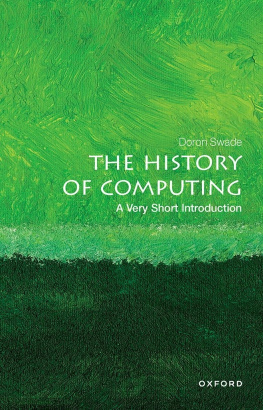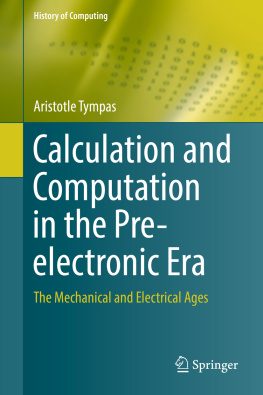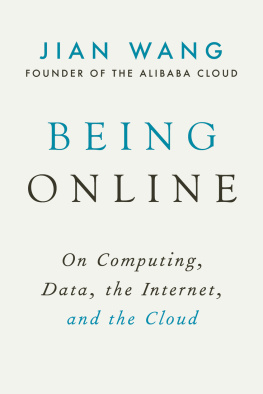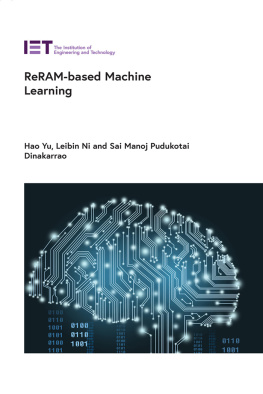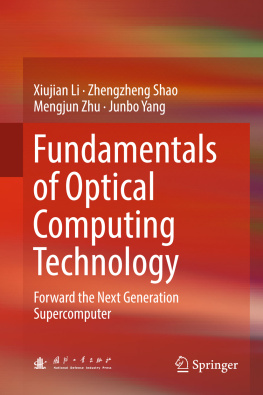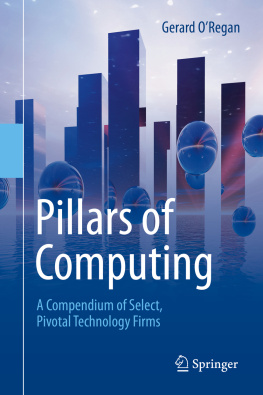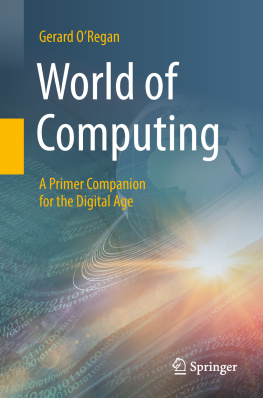Computing
MIT Press Essential Knowledge Series
Computing: A Concise History,
Paul E. Ceruzzi
Information and the Modern Corporation,
James Cortada
Intellectual Property Strategy,
John Palfrey
Open Access,
Peter Suber
Computing
A Concise History
Paul E. Ceruzzi
The MIT Press
Cambridge, Massachusetts
London, England
2012 Smithsonian Institution
All rights reserved. No part of this book may be reproduced in any form by any electronic or mechanical means (including photocopying, recording, or information storage and retrieval) without permission in writing from the publisher.
For information about special quantity discounts, please email .
Library of Congress Cataloging-in-Publication Data
Cerruzi, Paul E. Computing : a concise history / Paul E. Ceruzzi.
p. cm. (MIT Press essential knowledge)
Includes bibliographical references and index.
ISBN 978-0-262-51767-6 (pbk : alk. paper)
ISBN 978-0-262-31039-0 (retail e-book)
1. Computer scienceHistory. I. Title.
QA76.17.C467 2012
004dc23
2011053181
10 9 8 7 6 5 4 3 2 1
Series Foreword
The MIT Press Essential Knowledge series presents short, accessible books on need-to-know subjects in a variety of fields. Written by leading thinkers, Essential Knowledge volumes deliver concise, expert overviews of topics ranging from the cultural and historical to the scientific and technical. In our information age, opinion, rationalization, and superficial descriptions are readily available. Much harder to come by are the principled understanding and foundational knowledge needed to inform our opinions and decisions. This series of beautifully produced, pocket-sized, soft-cover books provides in-depth, authoritative material on topics of current interest in a form accessible to nonexperts. Instead of condensed versions of specialist texts, these books synthesize anew important subjects for a knowledgeable audience. For those who seek to enter a subject via its fundamentals, Essential Knowledge volumes deliver the understanding and insight needed to navigate a complex world.
Bruce Tidor
Professor of Biological Engineering and Computer Science
Massachusetts Institute of Technology
Introduction
A familiar version of Zenos paradox states that it is impossible for a runner to finish a race. First, he must traverse one-half of distance to the finish, which takes a finite time; then he must traverse one-half of the remaining distance, which takes a shorter but also finite time; and so on. To reach the finish line would thus require an infinite number of finite times, and so the race can never be won. The history of computing likewise can never be written. New developments transform the field while one is writing, thus rendering obsolete any attempt to construct a coherent narrative. A decade ago, historical narratives focused on computer hardware and software, with an emphasis on the IBM Corporation and its rivals, including Microsoft. That no longer seems so significant, although these topics remain important. Five years ago, narratives focused on the Internet, especially in combination with the World Wide Web and online databases. Stand-alone computers were important, but the network and its effects were the primary topics of interest. That has changed once again, to an emphasis on a distributed network of handheld devices, linked to a cloud of large databases, video, audio, satellite-based positioning systems, and more. In the United States the portable devices are called smart phonesthe name coming from the devices from which they descendedbut making phone calls seems to be the least interesting thing they do. The emphasis on IBM, Microsoft, and Netscape has given way to narratives that place Google and Apple at the center. Narratives are compelled to mention Facebook and Twitter at least once in every paragraph. Meanwhile the older technologies, including mainframe computers, continue to hum along in the background. And the hardware on which all of this takes place continues to rely on a device, the microprocessor, invented in the early 1970s.
Mathematicians have refuted Zenos paradox. This narrative will also attempt to refute Zenos paradox as it tells the story of the invention and subsequent development of digital technologies. It is impossible to guess what the next phase of computing will be, but it is likely that whatever it is, it will manifest four major threads that run through the story.
The Digital Paradigm
The first of these is a digital paradigm: the notion of coding information, computation, and control in binary form, that is, a number system that uses only two symbols, 1 and 0, instead of the more familiar decimal system that human beings, with their ten fingers, have used for millennia. It is not just the use of binary arithmetic, but also the use of binary logic to control machinery and encode instructions for devices, and of binary codes to transmit information. This insight may be traced at least as far back as George Boole, who described laws of logic in 1854, or before that to Gottfried Wilhelm Leibinz (16461716). The history that follows discusses the often-cited observation that digital methods of calculation prevailed over the analog method. In fact, both terms came into use only in the 1930s, and they never were that distinct in that formative period. The distinction is valid and is worth a detailed look, not only at its origins but also how that distinction has evolved.
Convergence
A second thread is the notion that computing represents a convergence of many different streams of techniques, devices, and machines, each coming from its own separate historical avenue of development. The most recent example of this convergence is found in the smart phone, a merging of many technologies: telephone, radio, television, phonograph, camera, teletype, computer, and a few more. The computer, in turn, represents a convergence of other technologies: devices that calculate, store information, and embody a degree of automatic control. The result, held together by the common glue of the digital paradigm, yields far more than the sum of the individual parts. This explains why such devices prevail so rapidly once they pass a certain technical threshold, for example, why digital cameras, almost overnight around 2005, drove chemical-based film cameras into a small niche.
Solid-State Electronics
The third has been hinted at in relation to the second: this history has been driven by a steady advance of underlying electronics technology. That advance has been going on since the beginning of the twentieth century; it accelerated dramatically with the advent of solid-state electronics after 1960. The shorthand description of the phenomenon is Moores law: an empirical observation made in 1965 by Gordon Moore, a chemist working in what later became known as Silicon Valley in California. Moore observed that the storage capacity of computer memory chips was increasing at a steady rate, doubling every eighteen months. It has held steady over the following decades. Moore was describing only one type of electrical circuit, but variants of the law are found throughout this field: in the increase in processing speeds of a computer, the capacity of communications lines, memory capacities of disks, and so forth. He was making an empirical observation; the law may not continue, but as long as it does, it raises interesting questions for historians. Is it an example of technological determinism: that technological advances drive history? The cornucopia of digital devices that prevails in the world today suggests it is. The concept that technology drives history is anathema to historians, who argue that innovation also works the other way around: social and political forces drive inventions, which in turn shape society. The historical record suggests that both are correct, a paradox as puzzling as Zenos but even harder to disentangle.
Next page

